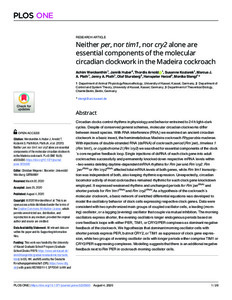| dc.date.accessioned | 2020-09-14T14:10:06Z | |
| dc.date.available | 2020-09-14T14:10:06Z | |
| dc.date.issued | 2020-08-04 | |
| dc.identifier | doi:10.17170/kobra-202009111789 | |
| dc.identifier.uri | http://hdl.handle.net/123456789/11813 | |
| dc.description.sponsorship | Gefördert durch den Publikationsfonds der Universität Kassel | ger |
| dc.language.iso | eng | eng |
| dc.rights | Namensnennung 4.0 International | * |
| dc.rights.uri | http://creativecommons.org/licenses/by/4.0/ | * |
| dc.subject | circadian oscillators | eng |
| dc.subject | cockroaches | eng |
| dc.subject | circadian rhythms | eng |
| dc.subject | biological locomotion | eng |
| dc.subject | genetic oscillators | eng |
| dc.subject | gene expression | eng |
| dc.subject | double stranded RNA | eng |
| dc.subject | RNA interference | eng |
| dc.subject.ddc | 570 | |
| dc.subject.ddc | 590 | |
| dc.title | Neither per, nor tim1, nor cry2 alone are essential components of the molecular circadian clockwork in the Madeira cockroach | eng |
| dc.type | Aufsatz | |
| dcterms.abstract | Circadian clocks control rhythms in physiology and behavior entrained to 24 h light–dark cycles. Despite of conserved general schemes, molecular circadian clockworks differ between insect species. With RNA interference (RNAi) we examined an ancient circadian clockwork in a basic insect, the hemimetabolous Madeira cockroach Rhyparobia maderae. With injections of double-stranded RNA (dsRNA) of cockroach period (Rm´per), timeless 1 (Rm´tim1), or cryptochrome 2 (Rm´cry2) we searched for essential components of the clock´s core negative feedback loop. Single injections of dsRNA of each clock gene into adult cockroaches successfully and permanently knocked down respective mRNA levels within ~two weeks deleting daytime-dependent mRNA rhythms for Rm´per and Rm´cry2. Rm´perRNAi or Rm´cry2RNAi affected total mRNA levels of both genes, while Rm´tim1 transcription was independent of both, also keeping rhythmic expression. Unexpectedly, circadian locomotor activity of most cockroaches remained rhythmic for each clock gene knockdown employed. It expressed weakened rhythms and unchanged periods for Rm´perRNAi and shorter periods for Rm´tim1RNAi and Rm´cry2RNAi.As a hypothesis of the cockroach´s molecular clockwork, a basic network of switched differential equations was developed to model the oscillatory behavior of clock cells expressing respective clock genes. Data were consistent with two synchronized main groups of coupled oscillator cells, a leading (morning) oscillator, or a lagging (evening) oscillator that couple via mutual inhibition. The morning oscillators express shorter, the evening oscillators longer endogenous periods based on core feedback loops with either PER, TIM1, or CRY2/PER complexes as dominant negative feedback of the clockwork. We hypothesize that dominant morning oscillator cells with shorter periods express PER, but not CRY2, or TIM1 as suppressor of clock gene expression, while two groups of evening oscillator cells with longer periods either comprise TIM1 or CRY2/PER suppressing complexes. Modelling suggests that there is an additional negative feedback next to Rm´PER in cockroach morning oscillator cells. | eng |
| dcterms.accessRights | open access | |
| dcterms.creator | Werckenthin, Achim | |
| dcterms.creator | Huber, Jannik | |
| dcterms.creator | Arnold, Thordis | |
| dcterms.creator | Koziarek, Susanne | |
| dcterms.creator | Plath, Marcus J. A. | |
| dcterms.creator | Plath, Jenny Aino | |
| dcterms.creator | Stursberg, Olaf | |
| dcterms.creator | Herzel, Hanspeter | |
| dcterms.creator | Stengl, Monika | |
| dc.relation.doi | doi:10.1371/journal.pone.0235930 | |
| dc.subject.swd | Tagesrhythmus | ger |
| dc.subject.swd | Biorhythmus | ger |
| dc.subject.swd | Schaben | ger |
| dc.subject.swd | Genexpression | ger |
| dc.subject.swd | RNS-Interferenz | ger |
| dc.type.version | publishedVersion | |
| dcterms.source.identifier | EISSN 1932-6203 | |
| dcterms.source.issue | Issue 8 | |
| dcterms.source.journal | Plos One | eng |
| dcterms.source.pageinfo | e0235930 | |
| dcterms.source.volume | Volume 15 | |
| kup.iskup | false | |


